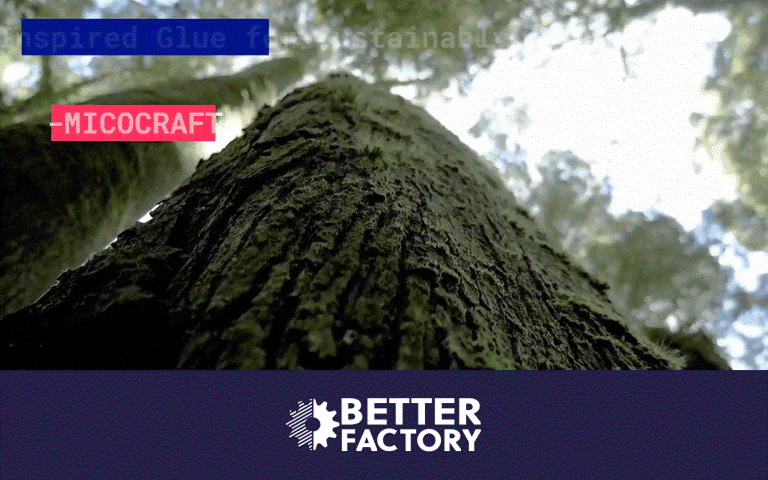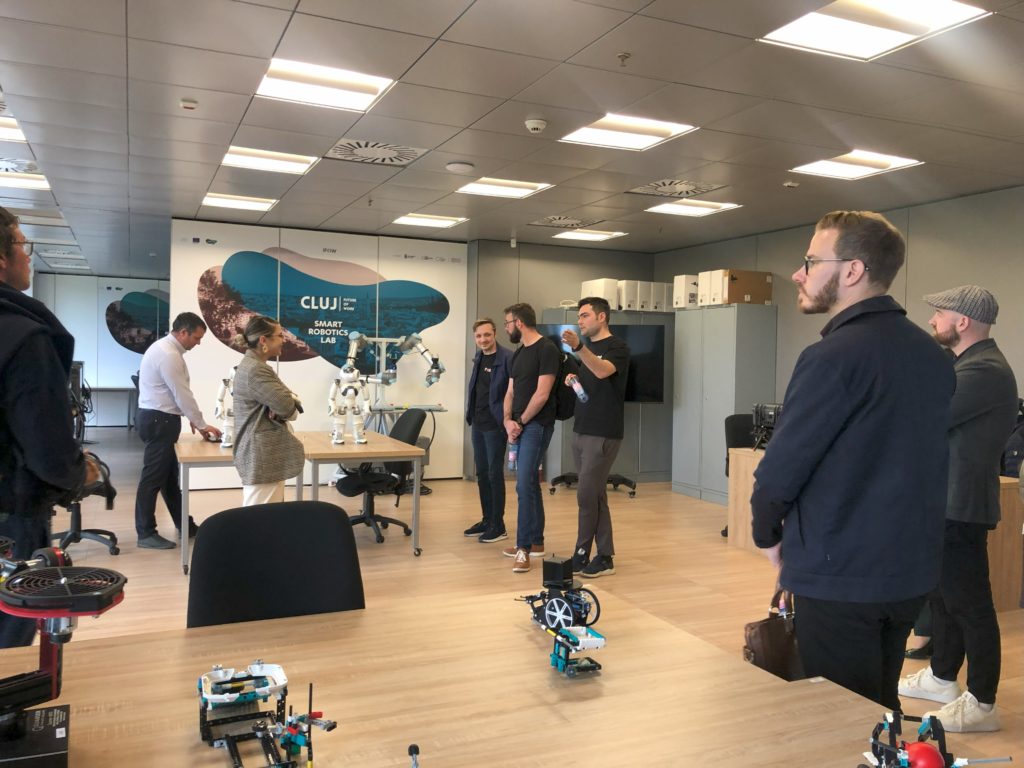
Over the next couple of weeks we’ll be running a series of 1:1 interviews with the KTE (Knowledge Transfer Experiment) teams that joined Better Factory through our second open call. These incredible teams are each made up of a SME, artist and technology provider, working together to develop new and personalized products, become cyber-physical systems, and transforming into Lean-agile production facilities.
The MICOCRAFT project focuses on the creation of innovative, nature-inspired products designed with mycelium technology for construction and packaging applications.
Their KTE team includes:
- Rongo Design (Manufacturing company)
- ONSITE STUDIO (Artist)
- SPE Global Solutions (Technology Provider)
Time to jump right into the interview – no more waiting!
Hello, thank you for joining us! To start off, could you tell us why you decided to apply to Better Factory?
SME Rongo Design: As a manufacturer that is focused on innovation by applying to this programme we can benefit from the added innovation of our products, thus responding to new market demands while maintaining the optimisation of production resources.
Artist ONSITE STUDIO: As an artist and a designer, collaborative projects are opportunities to imagine more inclusive creative strategies, where mutual understanding and specific knowledge permits global solutions.
The Better Factory gives a chance to create this kind of platform, extending the possibilities of innovation targeting product development and technological improvement.
This is even more true when we get to the Mission driven project, extending the possibilities beyond the direct challenges of the SME, in which future scenarios are developed.
Tech provider SPE Global Solutions We decided to apply because the project concept seemed interesting. We are a small company whose mission is to redefine cooperation between humans and robots and machines. The solution we are an integrator fits perfectly into the project’s assumptions, which involve the cooperation of a company such as SPE with an artist and an SME striving for mutual understanding and the construction of new ideas based on the interpenetration of hard engineering assumptions with artistic concepts. The project also seems to be a good start for gaining experience in working with European funds.
Can you describe the benefits of using mycelium as a construction material, and how does it compare to conventional solutions?
SME Rongo Design: Mycelium is a natural fungi material that has been explored as a potential construction material in recent years. It is a fast-growing matrix that has the capability to act as a natural glue, and mycelium composites have been promoted as an alternative construction material with less environmental footprint. By using mycelium, there is a huge reduction in the reliance on fossil fuels, the embodied energy required for fabrication, and a massive reduction in the building waste which is left at the end of the product’s life. Mycelium products can be molded to produce furniture, insulating panels, bricks with increased thermal and acoustic properties, wall and ceiling panels, biocement, and blocks and masonry units
Artist ONSITE STUDIO: I believe that the use of mycelium, and more globally natural processes within industry, is a way to respond to environmental and social issues.
“Collaborating with nature, instead of exploiting it, is a way to develop sustainable solutions. And when nature becomes our main partner, we have to take care of it. Adding not just value on a market level but also adding value on interactions between people, society, and environment, and this almost in a spiritual level.”
Artist ONSITE STUDIO
What challenges do you expect to face in the development of the robotic contour crafting and post-production arm, and how will you address them?
SME Rongo Design: The development of robotic contour crafting and post-production arm in the production of mycelium materials are new directions, through which an old technology, such as the mycelium technology, will be integrated with the new production technologies, with the clear aim of creating unique and bringing high added value in all phases of production, from the first stages in the production flow to the customization and uniqueness of the final product. Mycelium materials have unique properties that may require specialized equipment and techniques to handle, like robotic contour crafting and post-production arm. For example, the post-production arm will be able to handle additional steps efficiently and effectively, all design to face the challenges of future industrial models.
Artist ONSITE STUDIO: The work of the studio is related to the Digital Crafts era (that started with the Center for Bits and Atom at MIT in 2001). The use of computers, software programs and computer aides manufacturing tools in the context of small-scale workshops (or FabLabs). This is the environment that shaped our design practice.
Going now back to small and medium industry (where standardization and mass production is the main vector) and adding agility by the creative use of all technological elements (computers, software programs and computer aides manufacturing tools) is a challenge that meets the needs of future industrial models.
Through the use of the cobot and related Mimic technologies, we will investigate the role of the workers/employee within the manufacturing environment. Our system will need the input of specific skills that will be developed by our workers, using handiwork as an added value to the product, but also to the work itself. The Mimic technology gives us the opportunity to rethink the quality of the work, knowing that most of the interesting jobs (where skills and knowledge is needed) has been taken over by machines.
Tech provider SPE Global Solutions: When automating processes, one of the challenges is always standardisation. In this case, we must focus on the positioning system that ensures repeatability of manipulation or processing. A certain unknown for us is the repeatability of material growth in the molds. This means that each manufactured product may have a slightly different structure or colour. This may make it difficult to grip or handle. We need to conduct experiments, but we will focus on preparing flexible fixations, handles and adapting hand craft tools to work with the cobot.
How does the MICOCRAFT project contribute to reducing the CO2 footprint and negative manufacturing footprint, and what potential do you see for further impact in these areas?
SME Rongo Design: Mycelium materials have the potential to significantly reduce the CO2 footprint and negative manufacturing footprint. Mycelium materials can act as a CO2 sink, helping to achieve net-zero or even negative emission buildings. This is because the mycelium absorbs carbon dioxide during its growth process. Mycelium materials have a low embodied energy, which means that they require less energy to produce than traditional building materials. This can reduce the manufacturing footprint and contribute to a more sustainable manufacturing industry.

What other domains of manufacturing could benefit from the use of mycelium and collaborative robots?
SME Rongo Design: Mycelium and collaborative robots have the potential to benefit several domains of manufacturing. Robotic contour crafting and post-production arms can be used to automate the production process and improve efficiency. Moreover, the implementation of human-cobot collaborative manufacturing can improve occupational health and safety in manufacturing. By creating a safe and collaborative workspace between robots and humans, the risk of workplace accidents can be reduced. Likewise, by working side-by-side with humans, cobots can safely achieve greater output efficiency and quality.
Tech provider SPE Global Solutions: The common point between collaborative robotics and mycelium products is that many of their applications remain undiscovered. The simplest, basic applications and products are the most popular. In the case of cobots, these are applications related to manipulation – moving, packaging, palletizing. However, cobots have a huge advantage in favorable conditions – they can work side by side with humans. This opens up huge opportunities to support people in more demanding activities related to, for example, craftsmanship.
How does the project align with Rongo Design’s overall mission and values, and what role do you see MICOCRAFT playing in the company’s future development?
SME Rongo Design: Using mycelium materials and collaborative robots aligns with the overall mission and values of mycelium production. Mycelium production aims to create sustainable and biodegradable materials that reduce the environmental impact of manufacturing. Collaborative robots, or cobots, are revolutionizing the Rongo manufacturing processes by taking on repetitive, labor-intensive tasks, reducing human fatigue and error rates, and ultimately increasing efficiency and quality of Rongo products. The use of cobots and automation in the production of mycelium materials will improve efficiency and reduce the manufacturing footprint, aligning with the values of sustainability and reducing environmental impact that Rongo have in the ADN.
Finally, what do you hope will be the lasting impact of the MICOCRAFT project, and how do you see this project influencing other manufacturing industries in the future?
SME Rongo Design: The project «MICOCRAFT» are the embodiment of our vision to create a regenerative built environment that draws on nature for inspiration and innovation to create a step change in contemporary approaches to resource management and production methods. The Micocraft project aims to develop a project focused on human-machine cooperation, with human intelligence working in harmony with cognitive computing. By putting humans back at the heart of industrial production through collaborative robots, workers will be more skilled at performing value-added tasks in production, leading to mass customization and personalization for customers.
Tech provider SPE Global Solutions: In the project, we work on two levels – the first one related to the current challenges of SME, and the second one, which is a vision of the future. In both cases, the solutions we are working on are characterised by flexibility and modularity ensuring scalability. The freedom to adapt to changing demand and high product variability will fit into current production trends. If we add to this the fact that we work on 100% natural and biodegradable products, practical, obtained and processed locally thanks to the latest technological solutions. We believe that all or some elements of our experiment will be interesting for other manufacturing companies from various industries.
If you’d like to learn more about MICOCRAFT and their experiment, don’t forget you can check out their KTE page here!



